Preperation and planning
About Us

Who are we? Jack and Tan. I worked for a global computer company for 35 years and was recently divorced with 2 grown-up children, Emma and Timothy. My full time crew Tan is also divorced has 2 grown-up children, Rachel and Glyn, and was working for the local authority as an Deputy Registrar. At the age of 54 I was offered the chance to "take the package" i.e. receive a golden handshake and a company pension so I jumped at the opportunity without knowing what I wanted to do next. I was sure that I didn't want to stay in the computer industry as I believe that my "shelf life" was less than 6 months after which my skills would be passed their sell-by-date.
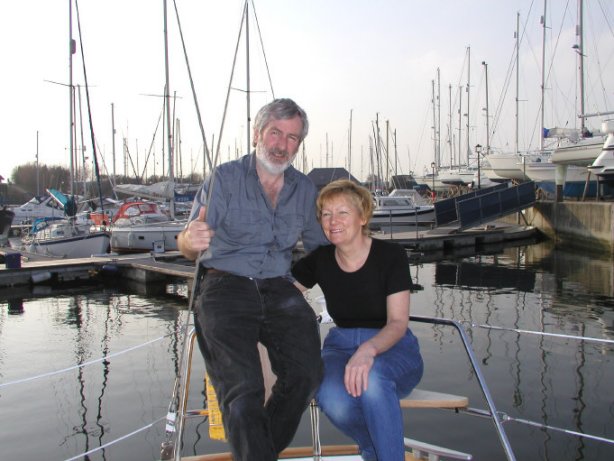 In the era BC (before children) I'd had my own boat, a 5 ton Hillyard which was moored in the river Exe at Starcross and would either sail or work on the boat almost every weekend with a friend called Norman. The more I thought about sailing again the more I liked the idea, but not as a part time hobby, so I asked Tan if she would like to sail around the Mediterranean with me and when she asked how long for, I said "as long as it takes and maybe a little longer". She fortunately said "yes" which was a brave decision for someone without any sailing experience at all and most of the time she doesnít regret it! She is now Chief Purser and Admiral.
In the era BC (before children) I'd had my own boat, a 5 ton Hillyard which was moored in the river Exe at Starcross and would either sail or work on the boat almost every weekend with a friend called Norman. The more I thought about sailing again the more I liked the idea, but not as a part time hobby, so I asked Tan if she would like to sail around the Mediterranean with me and when she asked how long for, I said "as long as it takes and maybe a little longer". She fortunately said "yes" which was a brave decision for someone without any sailing experience at all and most of the time she doesnít regret it! She is now Chief Purser and Admiral.
There is of course the big question of budget and finances, not just the purchase of the boat but the running and living costs. I have an apartment near Marchwood in Hampshire so I have rental income, add to that a pension from my ex-employer and it all seemed feasible (another spreadsheet).
I had no qualifications from my early days, none were required, in those days all you needed to enter France was a passport. We didnít have a life-raft and navigation was done by dead-reckoning supplemented by a hand-held RDF (Radio Direction Finder). We never got lost although on one occasion we tried to fix our position by sextant and the resulting plot showed us in the centre of Paris! The RYA is very good in recognising that experience counts so, after a pleasant but blustery wintry half day out on our new boat in the Solent with one of their instructors I had my International Certificate for Operator of Pleasure Craft. Mind-you I had to prove I knew what I was doing and he cleverly inserted many subtle questions into the conversation. I also had to have a CEVNI certificate to take the boat through the French canals. If you hire a boat on the rivers or canals in France and may never have set foot on a boat before you just get a brief chat, but if you own your own boat and know how to sail you have to have a certificate. Again, fortunately the RYA could do this at the same time, so now I had two pieces of paper.
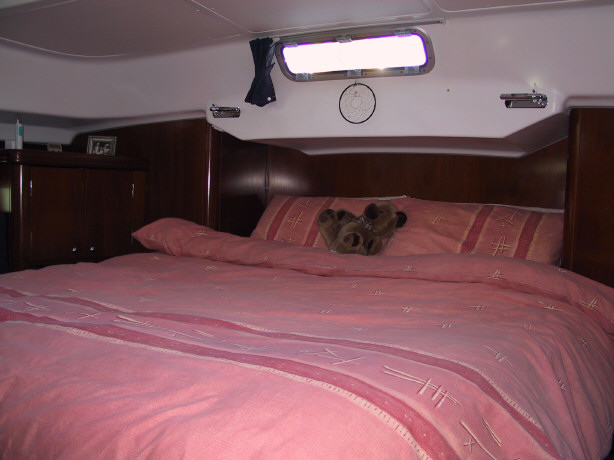
Owners Cabin
But, yet more Ė I needed a Maritime Radio Operators Certificate of Competence to use the VHF (even for emergencies) but at least itís for life. Oh, and thereís more, I also needed a radio licence for the equipment and I was strongly advised to get a Certificate of British Registry (Part 1) for the boat and decided to have the boat registered in Jersey, not for tax reasons, there arenít any, but because their certificate is for life whereas registering on the mainland has to be renewed every 5 years (since then a Jersey registry is valid for 10 years). Jersey registry were very efficient and pleasant to deal with unlike some stories I head about the mainland, but thatís just hearsay! Finally, a very welcome piece of paper Ė The RNLI Sea Check, which is a safety equipment advisory check by a skilled RLNI officer. It was very thorough and enlightening.
Our Beneteau Oceanis 42CC Top
The Beneteau Oceanis 42CC is a splendid class A (blue water) cruising yacht built for comfort not racing. It has a gorgeous owners cabin with a large en-suite toilet and shower and a self contained forward cabin with itís own toilet and shower. It has a well equipped galley with microwave, double sink and double fridge (no freezer due to power consumption). The 42CC has a lovely deep secure centre cockpit well sheltered by a fixed windscreen and a large aft-deck which can be slid back to reveal the drop-down transom which becomes the bathing platform with hot and cold shower.
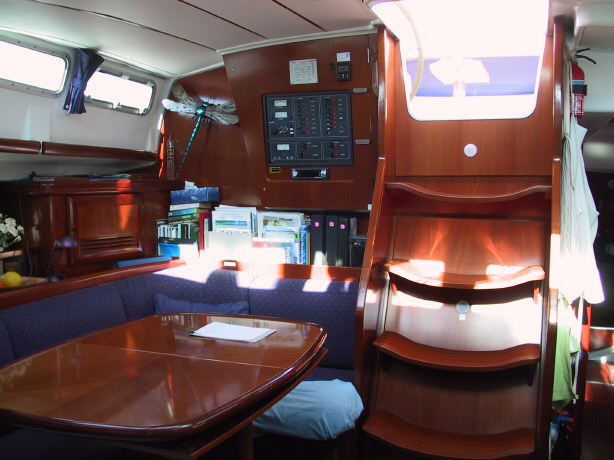 Salon
Salon
The engine is a Volvo 55hp installed in a capacious and well sound-proofed engine compartment with everything easily accessible. The 240 litre diesel capacity gives us about 120 hours running time, or roughly 600 nautical mile range assuming we never put the sails up. But thereís nothing better than being under sail and to turn the engine off.
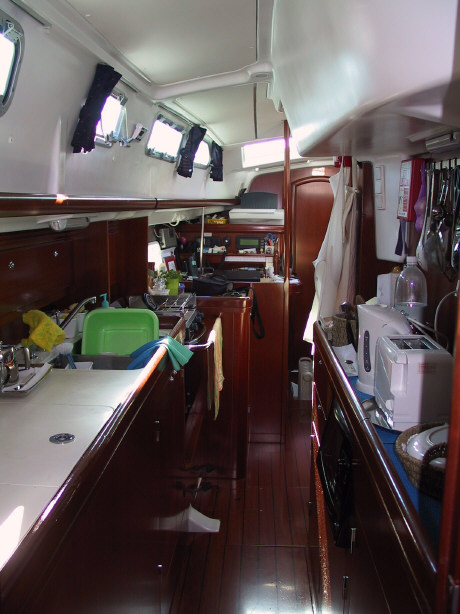 GalleyFor Navigation I chose the Raymarine RL72CRC colour chart plotter with combined radar overlay and had it installed in the cockpit in front of the wheel, normally practice is to install it by the chart table but I donít steer from there! I also had a link between the laptop on the chart table and the plotter which allows me to use the chart plotter and radar through the laptop as a full backup system. The boat has a built-in hydraulic steering system which is linked to the autopilot so we just select the place we want to go to on the plotter and off she goes.
GalleyFor Navigation I chose the Raymarine RL72CRC colour chart plotter with combined radar overlay and had it installed in the cockpit in front of the wheel, normally practice is to install it by the chart table but I donít steer from there! I also had a link between the laptop on the chart table and the plotter which allows me to use the chart plotter and radar through the laptop as a full backup system. The boat has a built-in hydraulic steering system which is linked to the autopilot so we just select the place we want to go to on the plotter and off she goes.
We also have a DSC VHF radio and a hand-held VHF radio for normal (and emergency) communication and for weather information I had a Navtext Pro installed which worked very well in the Solent but was practically useless in the Mediterranean until I installed a huge aerial. Later I bought a short-wave radio receiver, the Sangean ATS 909 which enables me to get 3 and 5 day forecasts and faxes via the laptop. A real god-send when at anchor in calaís.
Apart from the usual flares, horseshoe, danbuoy, liferaft, safety harnesses, etc. we had a rope cutter installed, three powder fire extinguishers and a new type of gas extinguisher by Sea-Fire for the engine compartment now that the very efficient Halon gas has been outlawed. For a meagre sum we also had a foot operated fresh water pump fitted in the galley, whatís the point of having all that water if you canít get at it in case of an electrical pump failure!
For comfort we chose an Eberspacher diesel hot air system with outlets in both heads, both cabins and the salon. It keeps us lovely and toasty on those cold Barcelona winter nights when the temperature gets into single digits. One of our best buys was a cockpit tent extension whose sides can be rolled up. It encloses the entire cockpit and provides a whole extra room in winter and acts as a greenhouse, airing cupboard, and also keeps us in the shade in summer and there is even a stereo speakers in the cockpit!
 Home on land
Home on land
A nice thing about a new boat is that you get to name it. Tan came up with the name "Blank Canvas" which for us represents a new start to life and our chance to paint our picture together. We registered Blank Canvas in Jersey because unlike the mainland where registration has to be renewed every 5 years, in Jersey it's for life and you get the "blue book" instead of a laminated A4.
Living on-board year-round also requires some serious thought about power consumption as well water capacity etc. We can manage about ten to twelve days on the 540 litre water capacity. For electric power I had an extra battery fitted on the domestic side so we have 420 Amp/hour and I installed a large combined battery charger and AC inverter by Studer which is capable of providing 2.5 kw continuous pure sine wave AC, enough to run Tanís hair dryer and the microwave and is intelligent enough to supplement shore-power if we should exceed the shore-power current rating. I deliberated about wind generators and solar panels but decided to leave it until we had some experience and understood our requirements better.
During our first summer at anchor we ran the engine for about 45 minutes each morning and evening which recharged the batteries and provided hot water. In 2004 I fitted a Sterling regulator on the engine alternator for more efficient battery charging. Initially we had a TV aerial fitted at the top of the mast but have never got around to getting a TV, we donít have time to watch it anyway but we do occasionally watch a DVD on the laptop.
Getting Ready Top
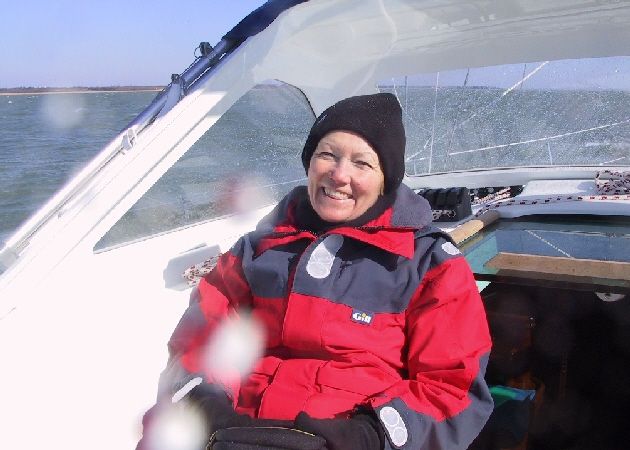 Brave Face!
Although hard work, it was also an exciting time. We ordered the boat in September and it was delivered to Ancasta for commissioning in January and we took delivery in early February. I spent most of my time working alongside the Ancaster team learing all the systems of the boat and installing some wiring and equipment of my own.
Brave Face!
Although hard work, it was also an exciting time. We ordered the boat in September and it was delivered to Ancasta for commissioning in January and we took delivery in early February. I spent most of my time working alongside the Ancaster team learing all the systems of the boat and installing some wiring and equipment of my own.
Tan and I have our own apartments 220 miles apart and Tan was still working. We decided to let our apartments to provide a much needed source of income. That meant we had to sell or store a lot of our furniture and our cars but itís amazing how much you can store in 42 feet of boat.
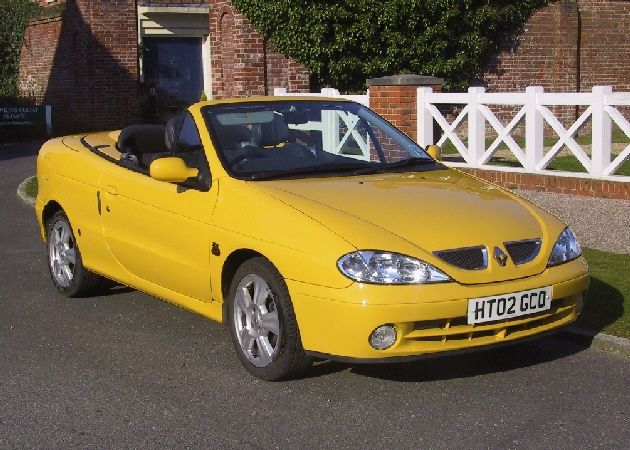 The car had to go
It has been many years since I owned my own boat and not having done regular sailing for a while we had to start from scratch in kitting out the boat and ourselves. Thank goodness for Boat Show. We were able to shop-around in a competitive environment and they even delivered the heavy gear to Ancasta free of charge. Weíd never have got the dinghy and outboard on the tube but we got funny looks with a boat hook!
The car had to go
It has been many years since I owned my own boat and not having done regular sailing for a while we had to start from scratch in kitting out the boat and ourselves. Thank goodness for Boat Show. We were able to shop-around in a competitive environment and they even delivered the heavy gear to Ancasta free of charge. Weíd never have got the dinghy and outboard on the tube but we got funny looks with a boat hook!
Despite all the preparation, most of the hard work was done in the last couple of weeks. This is when we had to pack our apartments and either move things onto the boat or store them. Then we had to test the boat and us! We did several trips around the Solent in various conditions and attended some excellent events held by Ancasta.
By the beginning of April we were living full time on the boat. It was our home, strange really because I could see my apartment from the Marchwood Yacht Club pontoon. We were ready to go but the weather didnít cooperate, it was the end of May before we finally set off across the channel but in the meantime we spent time in Lymington, Poole, Gosport, and around the Hamble.
Lifestyle Top
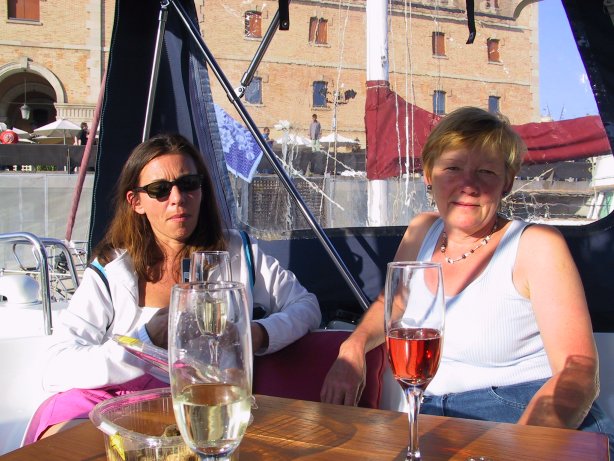 Relaxing
Firstly, this is NOT a holiday, itís a way of life, admittedly a very pleasant way of life. As such we have all the typical household chores to do, shopping, washing, cooking, washing-up. Yes, cooking and washing up, we canít afford to, nor do we want to eat out every night, in fact itís a treat for us to eat out. We donít have a lawn to mow but youíd be surprised how often the decks need cleaning.
Relaxing
Firstly, this is NOT a holiday, itís a way of life, admittedly a very pleasant way of life. As such we have all the typical household chores to do, shopping, washing, cooking, washing-up. Yes, cooking and washing up, we canít afford to, nor do we want to eat out every night, in fact itís a treat for us to eat out. We donít have a lawn to mow but youíd be surprised how often the decks need cleaning.
Our lifestyle and routine differs considerably between winter and summer. In winter we are moored to a pontoon so we can step directly from the boat onto land, we have an unlimited supply of water and electricity and thereís a washing machine in the marina although Tan still prefers hand-washing certain items on the pontoon. I strongly suspect thereís some dhobe-wallah in the blood somewhere. There are plenty of good shops of every type within a short walk and a plethora of sites to see and Barcelona has an excellent and cheap transport system as well as a convenient airport for visitors. The days are shorter but even the shortest day is considerably longer than in England and itís rare not to see the sun. Barcelona enjoys 300 sunny days a year, and although it can often be cold (now that weíve acclimatised) we also get lovely warm sunny (shirtsleeve) days.
 Barcelona Market
Barcelona Market
In summer we are typically at anchor in small bays or calas so going ashore is either by dinghy or swimming. We have a limited supply of power and water which usually lasts 10 to 12 days before refilling by visiting a Marina and buying water. Before we leave for the summer we provision with non-perishable food and other supplies so when at anchor we only need to go ashore every few days for fresh bread and perishable foods. A typical summer day involves getting the weather forecast, making the key decisions of the day, namely, to stay or move to another cala and what to have for dinner, then doing the chores, swimming, reading and going ashore to shop or explore.
Our diet varies considerably between summer and winter although the evening nearly always starts with a glass or two of Cava and a few tapas, usually olives and pickled garlic when we can get it. We donít have a freezer so most of our meals are made from fresh or dried produce, whateverís in season. In summer we eat a lot of salads (Tan does an excellent Niciose), chicken and fresh fish whereas in winter Tan makes various soups, casseroles, and we also eat quite a lot of rice and pasta and fresh fish. The microwave is particularly useful for slow-cooking on itís lowest setting. We have both lost weight and feel much healthier.
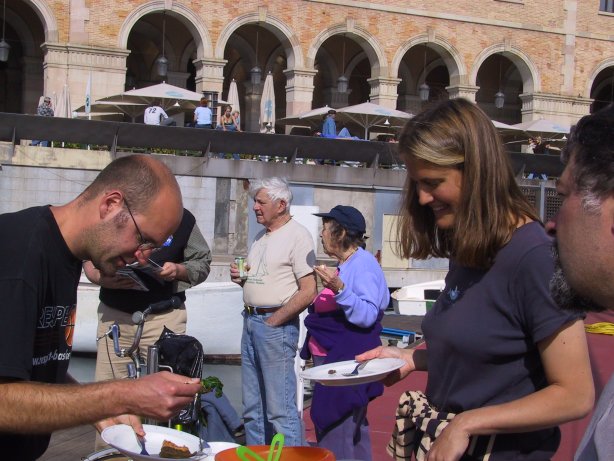 Pontoon Party
Pontoon Party
It may sound like a lonely life, far from it, we have made many new friends and acquaintances along the way, hardly surprising since most have a common interest. Even in summer at anchor we sometimes see the same boat several times and invite each other for drinks, but mainly itís in winter when we have the same neighbours for a few months. In Barcelona there is a good live-aboard community with a VHF radio network every morning (except Sunday) where we can share information about sourcing parts, social events, arrivals and departures, etc. Every Sunday, weather permitting there is also a pontoon party, bring a bottle and a dish to share Ė great. We are also very lucky to be visited by friends and family quite often, summer and winter.
How do you manage to live in just 42 feet of space? Remarkably easily, but it does help to be well organised and have a tidy nature and also be adaptable. A GSOH as the personal ads. say is also an advantage. Itís surprising just how much space and how much storage room there is, so much so that we still manage to loose things on the boat but we know theyíre here somewhereÖ.
Not everything is stress free, like Tan finding a good hairdresser or doctor, not easy when youíre on the move and not proficient in the language (yet) but we are both taking Spanish lessons. The medical care here is generally excellent and now that Britain has caught up with the standard E111 card it's great, but remember the E111 is for emergency traetment only. It's far better to register with your local Sanatoria if you need regular treatment. The service is excellent. Top